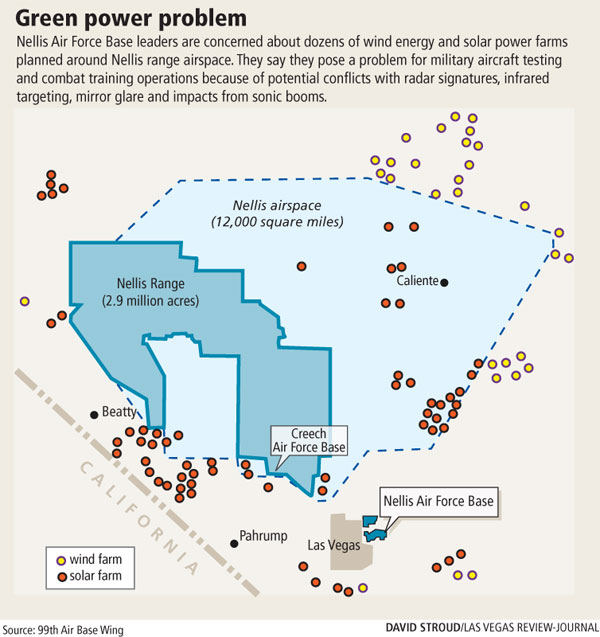Green power turning Air Force blue
Nellis Air Force Base officials are waving a red flag at the rush to put green power on the grid in Southern Nevada, at least for projects that may impede the base's training and testing missions.
The 12,000 square miles of airspace above the 2.9 million acres of the Nevada Test and Training Range, formerly known as Nellis Air Force Range, is the only place in the United States where pilots can drop live bombs and conduct air combat training at a level that compares with the places they fly overseas.
The climate and weather conditions around the range also are ideal for wind and solar power facilities, but placing them too close to the range could interfere with Air Force operations.
Air Force officials worry about the problems a solar tower's infrared glow could cause for a pilot who relies on infrared signatures for targeting.
The glare pilots could get from a misplaced solar mirror also concerns them, as does the damage that a sonic boom could inflict on an array of solar panels.
Wind turbines could interfere with radars used for air traffic control, navigation and airborne testing.
"We need to be able to use the range as an outdoor laboratory," said Col. Steven Garland, commander of the 99th Air Base Wing at Nellis. "We've got 68 years of investing in this pristine outdoor laboratory. You can't replace it anywhere else in the United States."
Today, Air Force leaders and Pentagon planners will launch a three-day forum in Las Vegas with invited officials from state and local governments, federal agencies and the green power industry.
Their message is for renewable energy developers and land use planners to slow down and work cooperatively with the Department of Defense so that green power projects can share the landscape without interfering with Air Force operations on the range.
"Both goals can be achieved. We just need to be smart about it," said Deborah MacNeill, director of public partnerships for the Nellis and Creech bases and the range.
Over the years, she said, as warplanes got faster and louder, the Air Force set up no-fly bubbles around Caliente, Pioche and other rural communities.
These bubbles are already problematic without adding wind turbines and solar mirrors to the equation.
Just one bubble "is a pothole in the middle of your basketball court," MacNeill said.
Col. John Montgomery, commander of the 98th Range Wing at Nellis, said the range, which is the size of Maryland and Connecticut combined, is "incredibly quiet" and can be used to test aircraft without interference from electromagnetic signals.
But if a large windmill 60 miles from the training range can affect radar signals, how does the military cope with enemy combatants who might use windmills or the glare from solar mirrors to foil warplane missions?
"If the mirrors are a problem in war, I'll blow them up. If it's going to be a problem, I'll take it out before my pilots get there," Montgomery said.
"If the windmills are a problem for me, they're also a problem for the nation that has them. You can't make the windmill not a target," he said. "And if I were attacking a country, I would attack from the windmills because they can't see me."
The bottom line is, windmills cause a problem to radars.
Montgomery said building one windmill in the wrong location without the Air Force having the ability to switch it on and off is like walking "into the laboratory and you sneezed in it, or an operating room and you sneezed in it."
"What are you going to do?" Montgomery asked. "You go get another operating room. I don't have another operating room. This is the only one I've got. And if we sneeze in it, then we can't go anywhere."
James Holland, deputy for installation policy at the Pentagon, said that while the Air Force is concerned about the potential effects from renewable energy facilities near Nellis and other bases, the service wants to work with all parties to develop compatible projects.
Holland said Air Force installations across the country "have varying degrees of vulnerability to mission degradation" from renewable energy projects, but those installations don't have any direct authority to halt or change the projects.
Montgomery said, "In these training airspaces, we need to tread lightly before we take something that we can never get back."
Contact reporter Keith Rogers at krogers@reviewjournal.com or 702-383-0308.























